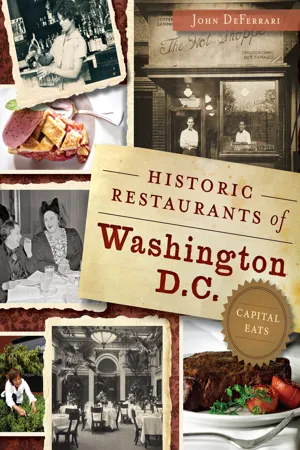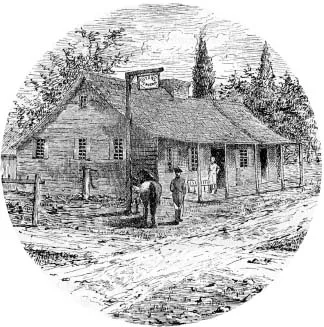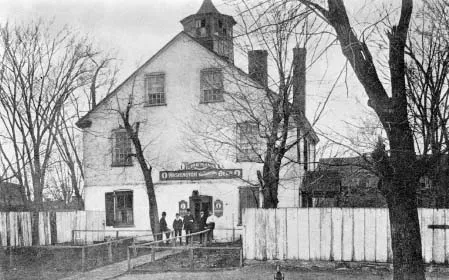![]()
Chapter 1
FROM TAVERNS TO RESTAURANTS
A traditional part of British and Dutch culture, taverns sprang up in the American colonies from their earliest days. The story of restaurants in Washington, D.C., begins with these taverns, which were around before there even was a Washington, and progresses through the early decades of the nineteenth century to the public eating houses that first focused on providing good food and service to their customers. From these, the modern restaurants would emerge in D.C. by the time of the Civil War.
EARLY TAVERNS
Early Washington’s taverns were not true restaurants as we conceive of them today—far from it. They didn’t have menus or waiters and were not primarily oriented toward meals. Instead, they were first and foremost drinking houses that also offered room and board. Drinking was the most popular form of public entertainment in the late eighteenth and early nineteenth centuries, when the average person drank three times as much alcohol as we do today. The food available at a tavern, usually only at set meal times, seems to have been of little interest to either tavern keepers or their patrons, even though important public dinners might take place there. Press accounts might describe a notable formal banquet at a tavern as “elegant” but generally did not bother to mention what kind of food was served. In contrast, a complete list of all the numerous toasts that had been offered—as many as fifteen or twenty at a fancy dinner—would frequently be included. In newspaper advertisements, tavern keepers vying for patronage were much more likely to describe their fine stocks of Madeira than the type of food they served, which did not vary from place to place.
Because of the emphasis on drinking, it is difficult to find precise information about the dishes that were served in Washington’s early taverns. Generally, the food was potluck and would be served buffet style, laid out on a long table in a big dining room. Guests—both boarders and local customers—would all be seated around the same table together. New Englander Samuel Vaughan listed in his diary in 1787 the kinds of food and drink that one would be likely to find at a country tavern, and the items might well have been found in Washington’s early taverns as well:
Ham, bacon & fowl pigeon of one sort or another always to be had upon the road & often fresh meat or fish, dried Venison Indian or Wheaten bread, butter eggs milk, often cheese, drinks Rum, Brandy or Whisky, resembling Gin.
Game was much more frequently encountered then than it is today, including venison, wild turkey, duck, pigeon and even bear. Pork was the primary type of meat served, often in the form of heavily salted ham. Potatoes, cabbage, beans, squashes and cucumbers were also common. But one didn’t usually go to a tavern anticipating a delectable meal. One went to learn the news, to socialize and to drink. Eating seems to have played little more than a supporting role.
It seems only fitting to start a book about the history of Washington restaurants with the tavern that served as the city’s birthplace—the site where an agreement was signed in 1791 to purchase the land for the new capital city. SUTER’S TAVERN, also known as the FOUNTAIN INN, was operated by John Suter (1744–1794) and hosted a number of key events connected with the founding of Washington. George Washington, John Adams, Thomas Jefferson and James Madison all dined there and often transacted important business within its walls. Georgetown had more than a dozen taverns in those days, but Suter’s was the best known and remains the most celebrated to this day.
Scottish-born John Suter opened the Fountain Inn in 1783, taking over an older tavern known as the King’s Arms, which had gone out of business. Suter seems to have quickly garnered a very good reputation for his exceptional liquor cabinet. He was said to have imported whiskey from his native Scotland, rum from Jamaica and brandy from the London docks. Thomas Jefferson once stated, “No man on the Atlantic coast can bring out a better bottle of Madeira or Sherry than old Suter.”
A fanciful drawing of Suter’s Tavern, as it appeared in Perley’s Reminiscences of Sixty Years in the National Metropolis, published in 1886.
George Washington’s diaries indicate that he first dined at Suter’s in August 1785, on a day when he came up to Georgetown for a meeting of the Potowmack Company, of which he was president. The company was building a canal to improve transportation along the Potomac River. Washington followed a similar pattern in October 1787, coming up from Mount Vernon for a Potowmack Company meeting, dining afterward at Suter’s (dinner in those days was served between noon and 3:00 p.m.) and then heading back into Virginia in the evening. Washington visited again for three days in March 1791 to finalize arrangements with key landholders to acquire the territory that would be designated the District of Columbia. Later, the sale of house lots in the new city would also take place at Suter’s, no suitable accommodations yet being available within Washington City itself. The tavern, like many of its kind, was an important community focal point, hosting meetings of Georgetown’s commissioners, operating a lending library and even staging productions of several dramatic plays.
John Suter died in 1794 at age fifty, perhaps after contracting cancer. His wife took over the tavern for a year or so before it passed into the hands of a succession of later owners. The wooden frame building eventually fell into disrepair and may have been torn down around 1835. At some point toward the end of the nineteenth century, people seem to have lost track of exactly where Suter’s Tavern had been located, and strenuous arguments were subsequently made advancing several different sites. The most likely location based on current scholarship is on the east side of Wisconsin Avenue (formerly Water Street), immediately north of the Chesapeake & Ohio Canal. Christian Hines (1781–1874), a prominent early Georgetown resident, located Suter’s at this spot in his Early Recollections of Washington City, and historian Oliver Wendell Holmes offered compelling evidence that this was the tavern’s most likely site in an article he wrote in 1974. However, we will probably never have conclusive evidence proving the famous tavern’s precise location.
Perhaps the most famous early tavern within the city limits of Washington was RHODES TAVERN, on the northeast corner of Fifteenth and F Streets, Northwest. F Street was one of the few streets in L’Enfant’s plan that was actually laid out in the early days of the city, and it became the city’s first residential core in the 1800s and 1810s. Rhodes Tavern, opposite the Treasury Department, was a natural public gathering point. Constructed in 1801, its first tenant was William Rhodes, who ran it as a tavern and boardinghouse. Like the Georgetown taverns, it became a de facto town hall for the new city, with city commissioners meeting there in 1801. The tavern served as the first polling place for a municipal election in 1802.
The building’s tavern days were few, however. In March 1814, the newly established Bank of the Metropolis purchased it, and it served as a bank for many years. Two-thirds of the building was torn down in 1957, but the corner section survived until 1984. A herculean effort to save the remnant was undertaken by a committed group of preservationists in the late 1970s. Appeals were made to influential officials, demonstrations were held and court suits were filed, all delaying the demolition for several years. In a citywide referendum held in November 1983, voters overwhelmingly endorsed saving the historic tavern, but it was not enough. The Supreme Court ruled in September 1984 that there was no legal basis for continuing to block the demolition, and the ancient building quickly came down. An office building now fills the site.
Rhodes Tavern, 1979. Library of Congress.
Tunnicliff’s Tavern in its 1880s beer hall days. Library of Congress.
Pennsylvania Avenue, the “Nation’s Main Street,” hosted several important early taverns, including TUNNICLIFF’S TAVERN, at what is now the southwest corner of Pennsylvania Avenue and Ninth Street Southeast. Constructed in 1796 in anticipation of the arrival of the federal government four years later, Tunnicliff’s was one of the first taverns in Washington City. It was built by Lewis Deblois, a Boston merchant who came to Washington to open both a store and tavern on land owned by Philadelphia speculator John Nicholson. In those early days, many people thought the eastern side would become the city’s central business district. Instead, the western part of Pennsylvania Avenue, on the other side of Capitol Hill, took on that role.
Deblois and Nicholson both encountered much frustration and bad luck in their real estate development efforts, but the tavern survived. When Deblois’s first tavern keeper quit on him, he hired William Tunnicliff, an Englishman. Tunnicliff ran the tavern from 1796 to 1799. Like Rhodes Tavern, Tunnicliff’s was more than just a place to room and board; it was also a multipurpose community center. An early social group, the Washington Dancing Assembly, met there. Most of the inn’s guests came from Maryland, traveling across the Anacostia River (then known as the Eastern Branch) via ferry, and the tavern became known as the Eastern Branch Hotel. It survived for more than one hundred years, being turned into a private residence in the 1820s and staying that way until after the Civil War. It served as a beer hall in the 1880s and later as a storage building. When it was torn down in 1931, it was being used as a gas station, and there is a gas station on the site to this day.
Taverns might be located at any key spot along a stagecoach route into or out of the city. An example was the GOOD HOPE TAVERN, built around 1820 on a hill just across the Eastern Branch River from the bustling Navy Yard on the southeast waterfront. The tavern’s location was near the current intersection of Naylor Road and Alabama Avenue Southeast. Not much is known about the tavern, including how it got its cheerful name, but perhaps it was meant to hearten weary travelers who had almost made it to the capital city. The tavern gave its name to the local community and a major Anacostia road. As a well-known landmark just outside the city proper, it became one of several popular dueling grounds, and in 1835, Francis Scott Key’s son Daniel was killed in a duel there with a fellow navy midshipman. The tavern survived at least until the 1920s, when the Sunday Star’s “Rambler,” J. Harry Shannon, sarcastically noted that the Good Hope Tavern had the distinction of not being one where George Washington had slept. It’s unclear when this modest establishment was finally torn down.
The tavern tradition, particularly in Georgetown and on Capitol Hill, has continued into modern times, though contemporary taverns bear little resemblance to their eighteenth-century forbears. Probably best known of today’s neighborhood taverns is MARTIN’S, located at 1264 Wisconsin Avenue Northwest in Georgetown. William G. “Billy” Martin (1894–1949), a Georgetown native and star athlete, opened Martin’s Tavern in April 1933, just as Prohibition was finally coming to an end. Georgetown was quite different in the 1930s, with few other restaurants competing for customers. As the first tavern keeper to open after Prohibition, Martin made a point of establishing a “respectable” joint. His dour, no-nonsense waiters enforced a conservative dress code and refused to let women sit at the bar (for their own good, of course). Men were prohibited from table-hopping, lest Martin’s gain a reputation as a pickup joint. It never did.
Martin’s Tavern on Wisconsin Avenue in Georgetown. Photo by the author.
Martin’s featured hearty, inexpensive fare and was popular from the start. As early as the World War II years, people would wait in long lines on weekend evenings. Every president from Harry S Truman through George W. Bush has dined at Martin’s, and John F. Kennedy is said to have proposed to Jackie Bouvier in booth three. In 1961, Evening Star writer Richard Slusser recommended the veal cutlet, calf’s liver sautéed with bacon and the “Old Virginia” crab cakes. Like many others, Slusser also liked Martin’s coleslaw, which he found “not at all vinegary and made of shredded cabbage instead of the blender-inspired mush swimming in liquid that is served in too many places.”
When the original Billy Martin, known as “Old Billy,” passed away in 1949, his son, William A. Martin, took over, and grandson Billy Martin runs the tavern to this day, making Martin’s one of the oldest continually operating restaurants in the city. Martin’s recently held a gala celebration of its eightieth anniversary, attended by the mayor.
THE FIRST RESTAURANTS
Returning to the first few decades of the 1800s, we find early restaurants emerging as a distinctly different kind of eatery from the city’s long-established tavern culture. Several factors played a role in the rise of this new style of public dining. The first modern restaurants, as we now know them, developed in France in the late 1700s. The French word restaurant originally referred to a type of meat bouillon that supposedly had restorative powers, the idea being that bouillon consisted of only the purest and most healthful “essence” of meat, which could be easily absorbed by the body and would not require digestive effort on the part of someone who was ailing. Sipping these “restaurants” became very fashionable among sophisticated elites in late eighteenth-century France. Further, in contrast to the rough-and-tumble taverns and cafés with their questionable clientele sanitation, the restaurateurs offered a more refined product and setting, individualized service and an appealing focus on customers’ health and well-being. These pioneers offered an entirely new and modern kind of dining experience, and soon businesses modeled on them were springing up everywhere in large cities.
In contrast to earlier taverns, restaurants were uniquely customer-oriented. They were open for extended periods of time, allowing customers to arrive and be served according to their own schedules, not just at fixed times. Parties of customers were seated at separate tables where they could receive individual attention from wait staff rather than being grouped at a communal table. And finally, restaurants allowed patrons to order dishes à la carte—from a menu—rather than offering only fixed meals (known as table d’hôte service). Empowered to tailor their dining experiences to their own tastes and whims, the new restaurant-goers must have been quite taken by the experience.
Delmonico’s, perhaps New York’s most famous restaurant, was one of the first to allow patrons to order dishes à la carte when it opened as a restaurant around 1830. Washington’s first restaurants opened soon thereafter. GEORGE KENSETT, an early restaurateur, ran an eating-house at Tenth Street Northwest and Pennsylvania Avenue. In 1833, he advertised in the National Intelligencer:
ON THE FOURTH OF JULY, and at all hours of every other day during the summer, will be served up, a la mode, at the corner of Tenth street and Pennsylvania Avenue, Beef Soups, Turtle Soup, Tripe, Fresh Oysters, Fresh Crabs, and all kinds of Eatables in season, and seasoned to be in season—so that any person wishing to enjoy the luxury of “something comfortable,” will be good enough to call and try for himself, at the said Restorateur.
GEORGE KENSETT.
N.B.—Bull Frogs for the Epicures this day.
In 1838, JOHN PRIVAUX, a former White House cook ...




